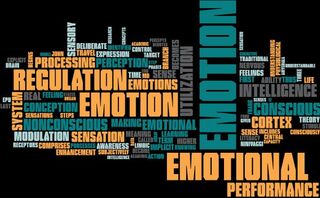Emotional Intelligence
Making Sense of Emotion
Innovating Emotional Intelligence
Posted September 13, 2021 Reviewed by Tyler Woods
Key points
- Learning effective emotion has four discernible steps.
- Emotion becomes feeling when cognition amplifies it with meaning.
- Emotions and feelings have both a non-conscious base and a conscious, malleable component.
- Learning about emotion is "Learned Mindfulness".
My recent book, Making Sense of Emotion, views emotional intelligence as "emotional literacy." This perspective on emotional intelligence suggests a new theoretical framework that breaks down emotional processing into the steps leading from an emotion's inception to its manifestation. Each term and concept in the field is defined for clarity and precision.

My clinical work at Yale for over forty-five years has shown that emotional regulation, often called "impulse control," "postponement of gratification," and "reward delay," sometimes becomes conflated with ill-defined terminology and theory. Making Sense of Emotion attempts clarification. The approach contrasts with conventionally established views that emphasize emotional regulation, often neglecting the steps to make emotion's experience, learning, and management a tangible reality. Making Sense of Emotion is emotional knowing, a four-step learnable process. As emotion comprehension expands, it innovates as robust emotional intelligence.
Academic psychology toggles between emotional intelligence (EI) as an intellectual ability or an ability tied into personality traits, emotions, and motivation. Scholars emphasize three branches emerging from statistical research:
- Perception
- Understanding
- Regulation
However, these branches neither capture nor use what makes sense clinically: emotion sensation. The Making Sense of Emotion model of emotional intelligence comprises four fluid phases:
- Emotion sensation
- Emotion perception
- Emotion conception (nonconscious modulation and conscious regulation)
- Emotion performance utilization and real-life consequences.
Making Sense of Emotion unpacks traditional "emotional regulation" by amplifying emotion conception and emotion performance utilization, thus clarifying and optimizing its effectiveness.
Emotional hygiene thus becomes learning emotional awareness—a developing capacity to notice emotions. Enhancement comprises spotting sensations, distinguishing them, and noting how they grow in complexity. Emotional intelligence, beginning in childhood, develops into emotional literacy in adulthood. These four phases or steps are not just theoretical, they are learnable. Fluid intelligence, memory, motivation, and environmental reinforcements influence how learning and real-world integration occur.
An Emotional Intelligence Lexicon
Emotion denotes a nonconscious physiological sensation. Emotions are automatically generated by the senses, triggering the brain's amygdala and limbic system. Feelings represent emotions subjectively identified as conscious percepts and understandable concepts. These cognitive enhancements occur when emotions travel from the limbic system to the higher cortex, giving meaning to nonconscious emotion. However, the terms "emotion" and "feeling" are typically used interchangeably. Mood refers to long-term feeling states. Affect is a technical term, the facial expressions elicited by nonconscious emotions, conscious feelings, and longer-term moods.
Emotional processing is the array of steps from the onset of emotion sensation through its perception, conception, and enactment in real life. Each step includes data transformations refining what goes forward.
The Making Sense of Emotion Contribution
Making Sense of Emotion contributes a new set of conceptual revisions with a revived, if not refined, vocabulary. While this summary outlines its high points, the book presents a deeper dive into the nuances of emotion, its valences, intensities, the dimensions that comprise distinct feelings, and the significance of motivation. Each of these makes individual differences real among people and in the same person over time. Emotion is a universal experience; the language explaining emotion is the way we organize this and support its expression socially.
Emotion Sensation
The implicit, visceral launchpad of all emotion begins here. Sensation is an unorganized awareness coded by the senses and sensed in the body. No specificity exists other than the raw experience of the stimuli-sense organ connection. A physical stimulus in the environment emits energy detected and absorbed by the sensory organ. This energy becomes neural messaging called "transduction." It travels from the body's periphery to the central nervous system, brain, and spinal cord.
Sensation in the periphery produces sensations felt both subliminally (nonconsciously) and consciously. Their only meaning is to withdraw or to attract.
Emotion Perception
When sensory nerve impulses reach the central nervous system, thalamus, amygdala, and cerebral cortex, they organize, test, and make judgments about the sensory data. The result is "perception." Perception is explicit, conscious awareness. The two processes of sensation and perception co-occur with no absolute distinction.
When sensory receptors are stimulated, nerve impulses are produced that travel to the central nervous system in what is called "bottom-up" processing. In the brain, "top-down processing" differentiates and interprets this "perceptual processing" to become experienced as a visual image, sound, taste, odor, touch, or pain.
Emotion Conception
The meaning that one's intellect imputes to emotion in an exact context is emotion conception. At this phase, nonconscious emotion becomes a conscious "feeling." This enhancement denotes emotions becoming subjectively identified as conscious percepts and expands as understandable concepts in the higher cortex, i.e., reflective reasoning. Commonly experienced feelings such as anger, fear, sadness, happiness, jealousy, guilt, surprise, and disgust are clearly defined and given meaning, interpersonally and socially.
Over decades, neuroscientists correlated distinct emotional experiences with brain regions:
- Orbitofrontal cortex: decision-making; risky choice taking
- Ventrolateral prefrontal cortex: abstract vs. concrete ability; probability of obtaining a goal
- Ventromedial cortex: emotional empathy
- Dorsolateral cortex: executive functions
- Dorsomedial cortex: cognitive empathy
- Broca's area (i.e., Brodmann areas 44 and 45): language
For the traditional EI (i.e., emotional intelligence) third branch called "emotion understanding," I prefer the more precise term "emotion conception." This phrase highlights the vast array of higher neocortical thinking, such as critical and executive functions that qualitatively transform sensation and perception into more rationally organized processing units.
Emotion conception is where meaning arises. This core processing comprises explicit critical and conceptual thinking, yet has implicit modulating features underlying it. These bridge the next and last target phase, emotion performance utilization. The traditional "emotion regulation" as one branch exists in my phases as two steps: three (comprehension) and four (emotion performance utilization). Thus, in Making Sense of Emotion, the academic one branch "emotion regulation"—I believe has two facets: (1) nonconscious modulation and (2) conscious regulation. My theory unpacks this conflation.
Emotion Modulation
Emotion regulation first begins as emotional modulation—the nonconscious base of all regulation. Concurrently, emotion regulation continues to operate with its conscious, intentional instruction from prefrontal cortical processes.
"To modulate emotions," however, includes modifying, tempering, attenuating, toning, regulating, controlling, supervising, stabilizing, steadying, guiding, and harmonizing the amplitude and emotional fluctuations toward stabler equilibrium. Modulation is more than mere change. Implicit learning and tacit knowledge occur. Regulation is more accessible to conscious, explicit awareness.
Emotion Regulation
Emotion regulation taps higher cortical processes and takes on conscious, explicit control based on nonconscious emotion modulation. When experts refer to "emotion regulation," they emphasize the last idea—implementing and expressing emotion in deliberate, intentional, and controlled behavior. Thus, emotion regulation commonly means consciously altering emotion to achieve skill delivery in real-time—restraint and checking unruly reactions are the hallmarks of this concept.
Emotion regulation emphasizes attempts at purposefully delaying, slowing down, and suppressing mental content and behavior. This effortful control includes the willful induction of executive attention and the deliberate suppression or inhibitory control of poorly considered responses. For example, studies show that job performance is advanced because of conscious emotion regulation. Also, school behavior and learning improve.
Emotion Performance Utilization
Emotion Performance Utilization (EPU) is the outcome and end-product of feelings manifest in actual experiences. This fourth, final target, "emotion performance utilization," is emotion's leading expression in real life. EPU reinforces the purposeful and deliberate direction with which emotion comprehension has been its primer.
Emotion Performance Utilization is a clinical, experiential, empirical, and behavioral implementation of emotional awareness. It is capability concretized into literal ability. EPU is the confluence of physiological and behavioral responses that encapsulate emotion's phases: sensation, perception, conception, and regulation into real-time action.
Emotion Performance Utilization is a more comprehensive concept and description than the traditional expression "emotion regulation."
EPU comprises two facets
- The nonconscious, implicit alterations occurring through emotional modulation
- The conscious, explicitly deliberate exercise of their expression in real life by effortful control
EPU shows how emotional knowing becomes mindful emotional literacy—the refinement of emotional intelligence.
Emotion Performance Utilization incorporates the vision and mission inherent in emotion conception by implementing these through combined nonconscious emotional modulation into strategically deliberate tactical action—goal achievement.
As a strategic learning enhancement, the Making Sense of Emotion theory makes transparent one's goals. Achieving these objectives or steps toward successful end-points is made possible by emotional insight. Emotion's sensations can be identified and monitored through their four-step development into becoming feelings. This emotional knowing is the purposeful key to successful life outcomes. Thus, learning emotional intelligence is possible by wholeheartedly making sense of emotion. Innovating emotions is adult behavior. Emotional literacy raises innovating emotions to an activity of daily living.
References
Alonazi, W. B. (2020). The Impact of Emotional Intelligence on Job Performance During COVID-19 Crisis: A Cross-Sectional Analysis. Psychology research and behavior management, 13, 749–757. https://doi.org/10.2147/PRBM.S263656
Ninivaggi, Frank John (2020). Learned Mindfulness: Physician Engagement and MD Wellness. New York, NY: Elsevier/Academic Press.
Ninivaggi, Frank John (2017). Making Sense of Emotion: Innovating Emotional Intelligence. Lanham, MD: Rowman & Littlefield.
Ninivaggi, Frank John (2013). Biomental Child Development: Perspectives on Psychology and Parenting. Lanham, MD: Rowman & Littlefield.
O'Boyle, E.H., Jr., Humphrey, R.H., Pollack, J.M., Hawver, T.H., and Story, P.A. (2011), The relation between emotional intelligence and job performance: A meta-analysis. J. Organiz. Behav., 32: 788-818. https://doi.org/10.1002/job.714
Salovey, P., Mayer, J., and Caruso, D. "Emotional intelligence: Theory, findings, and implications," Psychological Inquiry, 15, no. 3 (2004): 197.
Swanepoel, S., and Britz, L. (2017). Emotional Intelligence and Academic Performance. Alternation Journal, (20), 171-188. Retrieved from https://journals.ukzn.ac.za/index.php/soa/article/view/821




